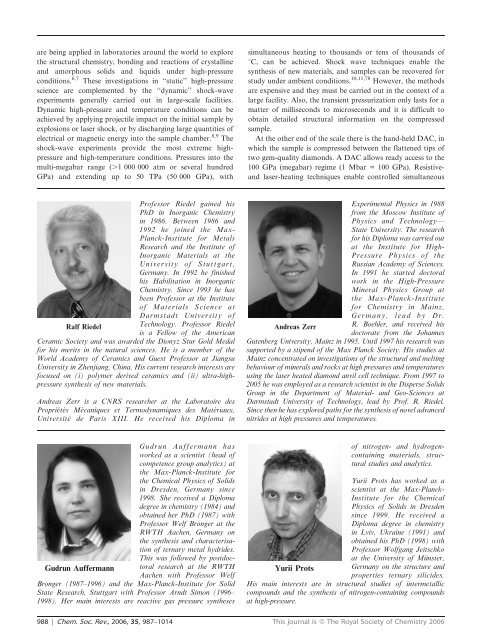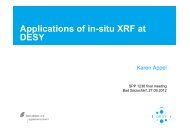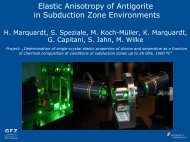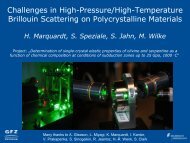High-pressure chemistry of nitride-based materials
High-pressure chemistry of nitride-based materials
High-pressure chemistry of nitride-based materials
Create successful ePaper yourself
Turn your PDF publications into a flip-book with our unique Google optimized e-Paper software.
are being applied in laboratories around the world to explore<br />
the structural <strong>chemistry</strong>, bonding and reactions <strong>of</strong> crystalline<br />
and amorphous solids and liquids under high-<strong>pressure</strong><br />
conditions. 6,7 These investigations in ‘‘static’’ high-<strong>pressure</strong><br />
science are complemented by the ‘‘dynamic’’ shock-wave<br />
experiments generally carried out in large-scale facilities.<br />
Dynamic high-<strong>pressure</strong> and temperature conditions can be<br />
achieved by applying projectile impact on the initial sample by<br />
explosions or laser shock, or by discharging large quantities <strong>of</strong><br />
electrical or magnetic energy into the sample chamber. 8,9 The<br />
shock-wave experiments provide the most extreme high<strong>pressure</strong><br />
and high-temperature conditions. Pressures into the<br />
multi-megabar range (.1 000 000 atm or several hundred<br />
GPa) and extending up to 50 TPa (50 000 GPa), with<br />
simultaneous heating to thousands or tens <strong>of</strong> thousands <strong>of</strong><br />
uC, can be achieved. Shock wave techniques enable the<br />
synthesis <strong>of</strong> new <strong>materials</strong>, and samples can be recovered for<br />
study under ambient conditions. 10,11,78 However, the methods<br />
are expensive and they must be carried out in the context <strong>of</strong> a<br />
large facility. Also, the transient pressurization only lasts for a<br />
matter <strong>of</strong> milliseconds to microseconds and it is difficult to<br />
obtain detailed structural information on the compressed<br />
sample.<br />
At the other end <strong>of</strong> the scale there is the hand-held DAC, in<br />
which the sample is compressed between the flattened tips <strong>of</strong><br />
two gem-quality diamonds. A DAC allows ready access to the<br />
100 GPa (megabar) regime (1 Mbar = 100 GPa). Resistiveand<br />
laser-heating techniques enable controlled simultaneous<br />
Pr<strong>of</strong>essor Riedel gained his<br />
PhD in Inorganic Chemistry<br />
in 1986. Between 1986 and<br />
1992 he joined the Max-<br />
Planck-Institute for Metals<br />
Research and the Institute <strong>of</strong><br />
Inorganic Materials at the<br />
University <strong>of</strong> Stuttgart,<br />
Germany. In 1992 he finished<br />
his Habilitation in Inorganic<br />
Chemistry. Since 1993 he has<br />
been Pr<strong>of</strong>essor at the Institute<br />
<strong>of</strong> Materials Science at<br />
Darmstadt University <strong>of</strong><br />
Ralf Riedel<br />
Technology. Pr<strong>of</strong>essor Riedel<br />
is a Fellow <strong>of</strong> the American<br />
Ceramic Society and was awarded the Dionyz Stur Gold Medal<br />
for his merits in the natural sciences. He is a member <strong>of</strong> the<br />
World Academy <strong>of</strong> Ceramics and Guest Pr<strong>of</strong>essor at Jiangsu<br />
University in Zhenjiang, China. His current research interests are<br />
focused on (i) polymer derived ceramics and (ii) ultra-high<strong>pressure</strong><br />
synthesis <strong>of</strong> new <strong>materials</strong>.<br />
Andreas Zerr is a CNRS researcher at the Laboratoire des<br />
Propriétés Mécaniques et Termodynamiques des Matériaux,<br />
Université de Paris XIII. He received his Diploma in<br />
Andreas Zerr<br />
Experimental Physics in 1988<br />
from the Moscow Institute <strong>of</strong><br />
Physics and Technology—<br />
State University. The research<br />
for his Diploma was carried out<br />
at the Institute for <strong>High</strong>-<br />
Pressure Physics <strong>of</strong> the<br />
Russian Academy <strong>of</strong> Sciences.<br />
In 1991 he started doctoral<br />
work in the <strong>High</strong>-Pressure<br />
Mineral Physics Group at<br />
the Max-Planck-Institute<br />
for Chemistry in Mainz,<br />
Germany, lead by Dr.<br />
R. Boehler, and received his<br />
doctorate from the Johannes<br />
Gutenberg University, Mainz in 1995. Until 1997 his research was<br />
supported by a stipend <strong>of</strong> the Max Planck Society. His studies at<br />
Mainz concentrated on investigations <strong>of</strong> the structural and melting<br />
behaviour <strong>of</strong> minerals and rocks at high <strong>pressure</strong>s and temperatures<br />
using the laser heated diamond anvil cell technique. From 1997 to<br />
2005 he was employed as a research scientist in the Disperse Solids<br />
Group in the Department <strong>of</strong> Material- and Geo-Sciences at<br />
Darmstadt University <strong>of</strong> Technology, lead by Pr<strong>of</strong>. R. Riedel.<br />
Since then he has explored paths for the synthesis <strong>of</strong> novel advanced<br />
<strong>nitride</strong>s at high <strong>pressure</strong>s and temperatures.<br />
Gudrun Auffermann has<br />
worked as a scientist (head <strong>of</strong><br />
competence group analytics) at<br />
the Max-Planck-Institute for<br />
the Chemical Physics <strong>of</strong> Solids<br />
in Dresden, Germany since<br />
1998. She received a Diploma<br />
degree in <strong>chemistry</strong> (1984) and<br />
obtained her PhD (1987) with<br />
Pr<strong>of</strong>essor Welf Bronger at the<br />
RWTH Aachen, Germany on<br />
the synthesis and characterisation<br />
<strong>of</strong> ternary metal hydrides.<br />
This was followed by postdoctoral<br />
research at the RWTH<br />
Gudrun Auffermann<br />
Aachen with Pr<strong>of</strong>essor Welf<br />
Bronger (1987–1996) and the Max-Planck-Institute for Solid<br />
State Research, Stuttgart with Pr<strong>of</strong>essor Arndt Simon (1996–<br />
1998). Her main interests are reactive gas <strong>pressure</strong> syntheses<br />
Gudrun Yurii Auffermann Prots<br />
<strong>of</strong> nitrogen- and hydrogencontaining<br />
<strong>materials</strong>, structural<br />
studies and analytics.<br />
Yurii Prots has worked as a<br />
scientist at the Max-Planck-<br />
Institute for the Chemical<br />
Physics <strong>of</strong> Solids in Dresden<br />
since 1999. He received a<br />
Diploma degree in <strong>chemistry</strong><br />
in Lviv, Ukraine (1991) and<br />
obtained his PhD (1998) with<br />
Pr<strong>of</strong>essor Wolfgang Jeitschko<br />
at the University <strong>of</strong> Münster,<br />
Germany on the structure and<br />
properties ternary silicides.<br />
His main interests are in structural studies <strong>of</strong> intermetallic<br />
compounds and the synthesis <strong>of</strong> nitrogen-containing compounds<br />
at high-<strong>pressure</strong>.<br />
988 | Chem. Soc. Rev., 2006, 35, 987–1014 This journal is ß The Royal Society <strong>of</strong> Chemistry 2006





